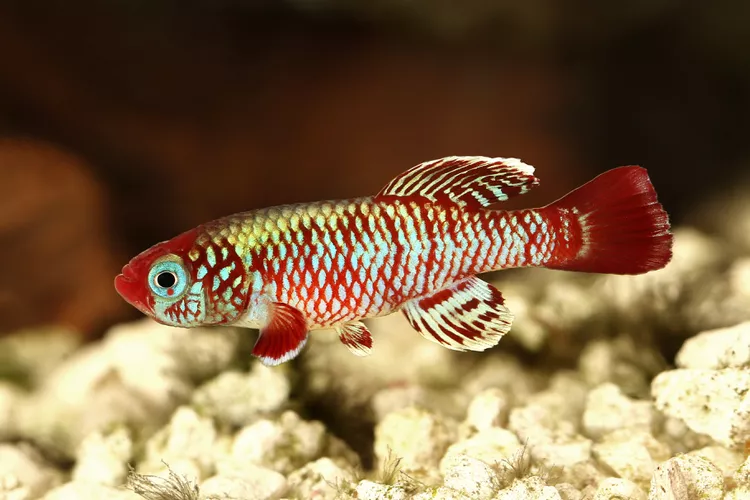
Size
The typical length is approximately 9 cm (3.5 inches). But they can grow up to 15 cm long (5.9 inches).
Physical characteristics and behavior
This appealing fish exhibits dimorphism, or morphological differences between men and females. The males are deeper in color and feature blue or orange markings during the breeding season. Females gradually transition from a silvery yellow on the ventral side to a more prominent yellow on the dorsal side. They also have vertical stripes around their flanks.
Habitat
The majority of killifish thrive in water that is between 68 and 75 degrees Fahrenheit, with a pH of 6.0 to 7.0, and a total hardness of 7 to 10 (120 to 160 ppm).
As Pet Requirements

- The water Requirements
Although many killifish are native to soft acidic water, captive-bred strains that have adapted to the water conditions in the area are becoming more widespread. Research killifish thoroughly before purchasing to learn what water conditions the fish were bred in. For the most part, killies thrive in water with a pH of 6.0 to 7.0, total hardness between 7° and 10° (120 ppm to 160 ppm), and temperature between 68° and 75° F. Preferred water parameters vary depending on the species. Although some seasoned keepers of killifish do not use filters (they perform frequent water changes! ), a hang-on-the-back or sponge filter is advised for the typical enthusiast. Use an Aqueon Aquarium Heater to maintain ideal filtration, a 10% weekly water change, or a 25% change every other week with an Aqueon Aquarium Water Changer or Siphon Vacuum Gravel Cleaner. Before refilling your aquarium, remember to treat the tap water with Aqueon Water Conditioner!
- Housing Recommendations
Due to their small size, many killifish are ideal for nano and desktop aquariums. A trio can be kept in a specific tank that is 5 to 10 gallons in size, but for community aquariums or if you wish to keep more than one male, a 20-gallon aquarium or greater is advised. Low light-tolerant plants like Cryptocorynes, Java moss, and Java fern should be used in non-breeding tanks, coupled with muted lighting, driftwood or peat moss to soften the water and reduce pH. Killifish are skilled jumpers, thus a secure lid is essential!
- Diet
In the wild, many Killifish are classified as carnivores and consume brine shrimp, worms, and other types of crustaceans. However, other species would fall under the category of omnivores and eat primarily algae and other plant matter.
These fish ought to be offered adequate food in the aquarium that closely resembles what they would typically consume in their natural environments. If you intend to breed your Killifish, you need to pay extra care to feeding it a balanced diet that contains the nutrients it needs for optimal health and breeding success.
- Tank mates
When living in the wild, killifish are by nature schooling fish. This means that in order to protect their health and wellbeing, they need to be kept together in a group. When by themselves, they are prone to stress. It’s crucial to keep in mind that male Killies can become hostile with one another if there are two or more of them.
Recommended tank mates for Killifish include: Danios (we love the Celestial Pearl) (we love the Celestial Pearl), smaller species of catfish, Tetras (neon, green, and ember) (neon, green, and ember), Rainbow fish and other calm fish.
Table





